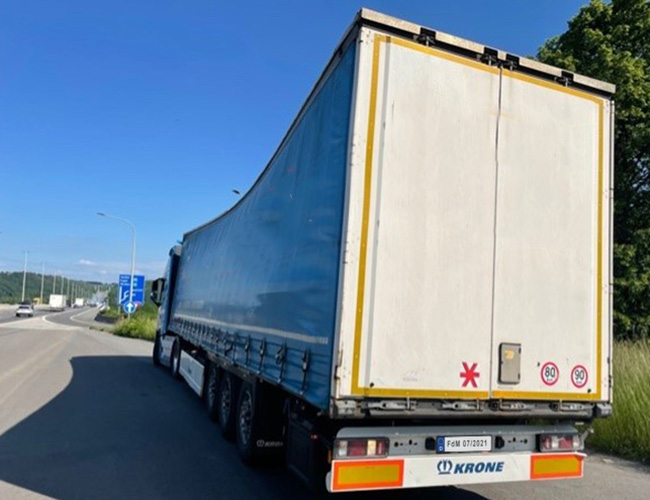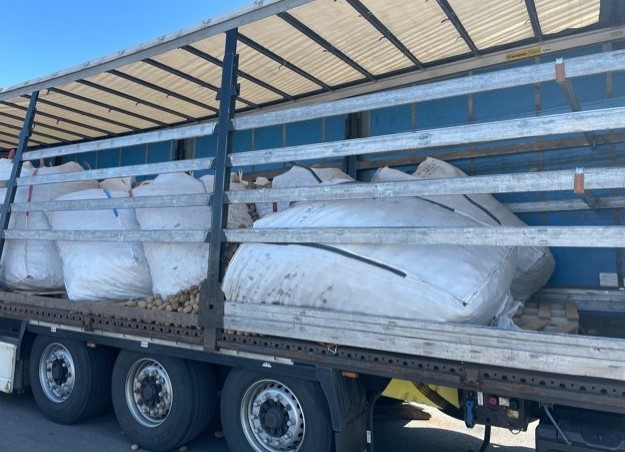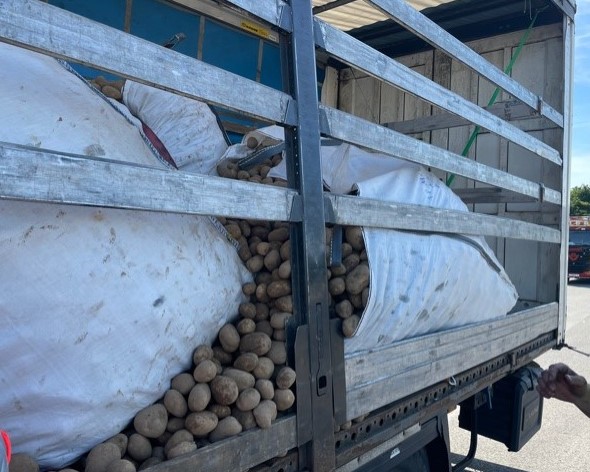| Photo of the month – July 2021 |
[German version] |
The mashed potato
or rocking and rolling big bags
Our Belgian neighbors or, to be more precise, the Belgian police, keep a close eye on things. The shadow cast by the trailer says pretty well all there is to say:

Figure 1 [Raymond Lausberg]
We could guess that the whole of the support has slipped to the right of the vehicle, but we have better photos to show what happened:

Figure 2 [Raymond Lausberg]
And we were not mistaken. The load has not only slipped – it has also tipped and rolled. Potatoes in big bags acting as large sacks have been balanced on top of one another across the loading bed. And no attempt was made to secure them! The two retaining boards that can be seen at the far right of the picture are probably purely cosmetic. They may look good, but when confronted with big bags filled with potatoes, they are just a bad joke.

Figure 3 [Raymond Lausberg]
This photo shows the full extent of the loss. There is no sign of any attempt to secure the load. That’s all very well, but how could the load have been secured properly? Not on this vehicle, that’s for sure: If the load is not packaged and is carried loose in open big bags, it has to be transported as a tight fit. With a bit of luck, the bags will keep the load together when it is not moving, but they have no chance of withstanding the stresses of transportation with a load that is liable to roll.
A word about packaging:
When is it possible to bundle loose cargo to form a stable unit that can perhaps even be secured with tie-down lashings? To do this, a bag needs to be completely filled and closed. Flour, sugar, cement and so on compress well and can be filled into sacks so that they can be bundled on a pallet to form a sensible load unit. The problem here is often the lack of friction between the individual sacks and between the sacks and the pallet, but this can be resolved by the use of adhesives, for instance.
Big bags are more difficult, because even the slightest tendency of the load to creep or move propagates throughout the whole bag. Tie-down lashings are generally no longer an option, and direct lashings must be used.
Open big bags with loose cargo that furthermore has an extreme tendency to roll simply cannot be secured sensibly. No matter what is done to try to get a grip on the bags, the load cannot be secured as long as it has a way of escaping. It might be possible to use what are known as “1g boards” or similar boards as dividing walls to create compartments and then secure the load with a lashed tarpaulin. In this case, the tarpaulin would take over some of the jobs of the packaging. But securing the load like this would be extremely time-consuming and there is no guarantee that it would be adequate. Which means that it is not really an option. Anyone who wants to transport cargoes like this needs a rigid body vehicle such as a box body or a container.
So what was the problem here? That’s right: the packaging and the loader. How can someone send a driver out onto the roads with a load like this? We can only hope that the freight forwarder and/or the carrier will have to pay a hefty fine, because the vehicle was not suitable for carrying this load. Period.
The loader has clearly taken leave of his senses: This type of “packaging” is possibly suitable for storage or for moving the cargo around the warehouse. But if the cargo is to be moved around the warehouse on pallets rather than being slung vertically, it is just a matter of time before the warehouse will be awash with potatoes.
As always, the driver is the weakest link, and of course he “deserves” to be fined in the same way as the others involved. But we would hope that the fine is not too large. The freight forwarder / carrier should be footing the bulk of the fine.
We wish you a safe and secure summer.
Back to beginning
